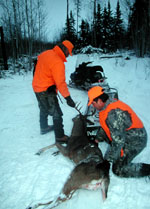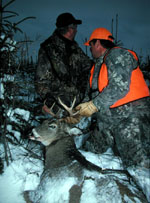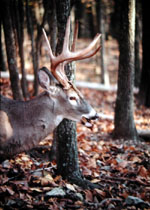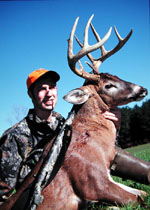
|
Features
|
|
|
|
Books
|
|
|
|
Fun & Games
|
|
|
|
Contact Us
|
|
|
John's Journal... Entry 132, Day 5
TWO-ON-ONE WHITETAILS
How Deer Dictate Where We Hunt
 EDITOR'S
NOTE: Two hunters can take twice as many whitetails
as one hunter can, and two hunters often bag bigger whitetails than one
hunter will. Many of the trophy whitetails bagged in America today are
taken when hunters double-up on bucks, because trophy whitetails know
more about the hunters who hunt them than the sportsmen understand about
the deer that sport high racks and heavy body weights. Find out this week
how doubling-up on deer greatly can increase your chances for bagging
that trophy buck.
EDITOR'S
NOTE: Two hunters can take twice as many whitetails
as one hunter can, and two hunters often bag bigger whitetails than one
hunter will. Many of the trophy whitetails bagged in America today are
taken when hunters double-up on bucks, because trophy whitetails know
more about the hunters who hunt them than the sportsmen understand about
the deer that sport high racks and heavy body weights. Find out this week
how doubling-up on deer greatly can increase your chances for bagging
that trophy buck.
One of the main reasons to hunt whitetails two-on-one is because of the deer's highly developed senses of smelling, hearing and seeing, as well as other prime physical attributes. Let's look at what wildlife biologists have learned about the white-tailed deer's physical characteristics that makes hunting and bagging them difficult.
* Smelling -- because the deer's sense of smell helps it identify things, buddy hunters must carefully eliminate the human scent from their clothes, boots, trails they walk into the woods, blinds and tree stands. Also, smell attracts whitetails to certain foods and causes them to investigate unusual objects in the woods, which suggests that friends hunting whitetails together also should use deer lure.
* Hearing -- the deer's acute sense of hearing and its large, constantly alert ears help it to locate hunters. Making sounds to purposefully spook deer to flee in a certain direction toward a waiting stander can pay buck dividends.
 *
Seeing -- The white-tailed deer has monocular vision to each side and
binocular vision to the front, giving it a wide field of vision. The structure
of the deer's orbit and the size of the deer's retina allow a deer to
see back along its flank and detect objects behind it. Deer, which depend
on motion and depth perception to locate and identify objects, also have
the ability to focus on nearby and distant objects at the same time.
*
Seeing -- The white-tailed deer has monocular vision to each side and
binocular vision to the front, giving it a wide field of vision. The structure
of the deer's orbit and the size of the deer's retina allow a deer to
see back along its flank and detect objects behind it. Deer, which depend
on motion and depth perception to locate and identify objects, also have
the ability to focus on nearby and distant objects at the same time.
* Running -- As Donald Spence emphasizes, he prefers to spook a buck just enough to make him walk slowly out of his hiding place rather than run from it, because deer run at only two gaits: trotting and galloping. Deer are good runners because of the design of their skeletons and musculature. When trotting, deer look straight forward with their heads held erect. They may gallop at speeds up to 36 miles per hour, taking several long strides between each high bound.
 When
hunting deer, follow these safety tips:
When
hunting deer, follow these safety tips:
* Always wear orange.
* Always have an appointed time to meet your buddy at the end of the drive
or the hunt.
* Always assume everything you can't see or identify is your buddy or
another hunter.
* Always let your friend know whether you've hit or missed a deer after
you've taken a shot.
* Never sneak up on a buddy.
* Never assume you and your friend are the only two hunters driving or
hunting a particular woodlot.
* Never shoot in the direction of your hunting buddy.
* Let any other hunters you see approaching know where you and your buddy
are.
* Keep visual contact with your hunting partner as much as possible.
* Don't alter any hunt plan you and your friend have set up without first
notifying your buddy.
 To
learn more about hunting deer, return to Night Hawk's homepage, and click
on books on the left side. You can use PayPal or call (800) 627-4295 to
order.
To
learn more about hunting deer, return to Night Hawk's homepage, and click
on books on the left side. You can use PayPal or call (800) 627-4295 to
order.
Check back each day this week for more about The Super Gene ...
Day 1 - Increase Your Whitetail
Knowledge
Day 2 - Team Tactics for Clearcuts
Day 3 - Double Rattling
Day 4 - Hunting Hills and Hollows
Day 5 - How Deer Dictate Where We Hunt